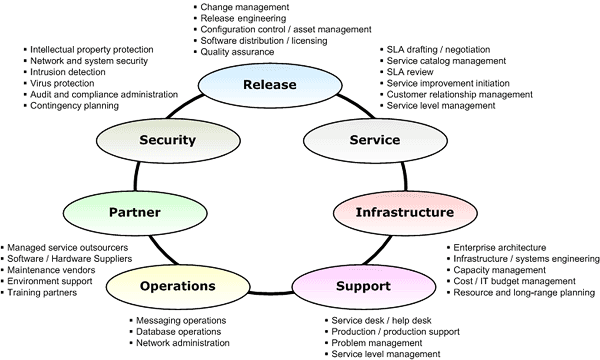The Microsoft Operations Framework (MOF) Team Model organizes the activities of IT operations into seven distinct role clusters that represent areas, or functional roles, within IT operations where particular staff members or groups are performing activities toward a shared goal or a similar mission of service.
These role clusters do not imply or suggest any kind of an organization chart or a set of job titles because this will vary widely by organization and team. IT organizations will implement aspects differently, depending on the size of the group, the scope and boundaries of the systems, the geographic locations, the resources available to the team, and the specialties and experiences of the individual staff. For example, operations management groups within corporate enterprises, small businesses, educational institutions, e-businesses, and hosting and application service providers-while all requiring a common baseline of operational functions-will each also have distinct operational needs for their specific businesses.
The following figure provides some examples of these key functional roles or function teams and how they align with the MOF Team Role Clusters. The functions listed are just a few of the many functional roles or function teams that may exist in service management organizations.

The number of people required to perform each role will vary widely. In smaller operations-management organizations, one person often performs multiple roles. In larger IT organizations, however, entire function teams may be allocated to perform a single, specific functional or procedural role.
As companies evolve into virtual enterprises and geographically disparate teams dependent on numerous partners for daily operational support, the functional roles in the operations teams will include dedicated process owners, such as availability management and change management. This is also a way to weave in the dedicated process ownership concepts described in ITIL while combining them with tactical and technology-specific function teams. The process and functional combinations result in virtual process teams-in other words, cooperating groups of people from internal and external resource pools that get the work done collectively.
A Balanced Approach
To better understand IT operations teams, it is necessary to understand that each team has different objectives and to balance those objectives in a controlled manner. If any single team's objectives overlap those of other teams, then operational inefficiency can result as each team competes with the other to meet its individual mission. Maintaining a balance between teams and knowing when to seek compromise, together with maintaining a focus on the need to deliver quality IT services to the business, keeps everything in check. To accomplish this, good communication is essential.
Importance of Communication
Communication is at the center of the MOF Team Model-and all Framework models-by design. Textbooks have been written on the importance of effective communications in general and in particular industries specifically, and it is certainly a key component of an effective and efficient IT operations organization. Several specific ways for operations management groups to communicate effectively have been identified as best practices and are easily repeatable. These include:
- Daily or regularly recurring brief triage meetings within each
role group, or within all roles working on a specific system, that
provide updates on key or time-critical system and business issues
and on the action needed.
- Customer-viewable Web pages on the intranet or Internet as
appropriate, relaying operational statistics such as uptime, number
of customer visits, performance trends, open issues and
escalations, and so forth.
- An operations-owned go/no-go meeting with the development and
deployment teams in final preparation for a release to production.
This sign-off indicates that all operations management groups are
prepared and ready to take on operational support of the product or
system.
- Regular status reports in a format that is easy to distribute
and read (e-mail, for example), delivered to IT management and the
business community on key performance indicators for operations
(for example, metrics against service level agreement, help desk
log statistics, progress toward division goals, and so
on).